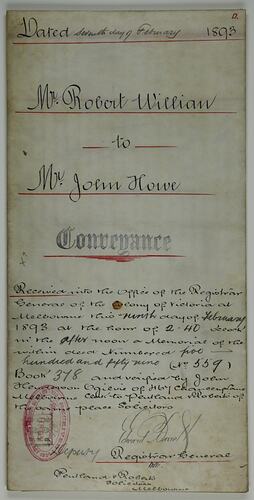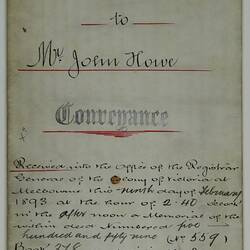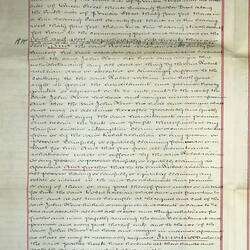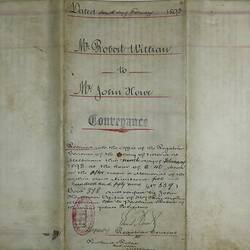Summary
Handwritten and printed Conveyance dated February 9, 1893. Mr Robert Willian conveyed the Princes Street property to Mr John Howe. This conveyance was verified by John Henderson Ogilvie, Melbourne, clerk to Pentland & Roberts, solicitors. Edward Barrett, Deputy Registrar-General, signed this document.
This is the last of four such documents representing the financial dealings of Robert Willian and others, regarding this same property over the space of eight years. Robert Willian borrowed sums of money from two different creditors against this property over that period. Eventually being unable to make repayments, this piece of land became property of John Howe in 1893, as documented by this conveyance.
Robert Willian was born in what is now Port Melbourne in 1862. Working as a blacksmith for the Victorian Railways from 1880 until 1922, Robert spent his early life in the Williamstown area, later moving to the Ballarat area where he died in 1927.
This document was witnessed by W.H. Roberts, solicitor, Williamstown. He was probably William Henry Roberts, solicitor of Williamstown, for whom John Howe built the heritage listed 'Tudor House', on Pasco Street, Williamstown in 1884.
Physical Description
One sheet document folded three times, with title, date and names on cover. Postage stamp and textile ribbon on cover. Large amount of text printed and written in black ink with ruled red ink borders and underlining. Two postage stamps on inner page. Red wax seal on another inner page.
Significance
These documents, and the related personal stories, are significant to the state of Victoria and also to the areas of Williamstown and potentially Ballarat. They represent a single person's financial and personal struggles but also place this man within the larger context of the Depression of the 1890s and the many affected.
Aspects of the lives of the people mentioned in these documents (and their families) represent a community's involvement with events and themes in Australia's history that many feel define the nation, including immigration and a pioneering spirit of adventure, both world wars, the depression of the late 19th century. and the influenza pandemic of the early 20th century.
The documents also suggest a sense of community - both as part of Williamstown's Scottish community and the wider Williamstown community.The men involved in this property's history were workers, doctors, architects, carpenters; rich and poor, yet they were all part of one close and vibrant community, where 'class', in the traditional sense of the word, did not appear to limit people's interactions with one another.
More Information
-
Collecting Areas
-
Acquisition Information
Purchase
-
Person Named
Mr Robert M. Willian, Williamstown, Greater Melbourne, Victoria, Australia, 1893
-
Person Named
Mr John Howe, Williamstown, Greater Melbourne, Victoria, Australia, 1893
-
Inscriptions
Front cover title: 'Dated Seventh day of February 1893, Mr. Robert Willian to Mr. John Howe, Conveyance. Received into the offices of the Registrar General of the Colony of Victoria at Melbourne this ninth day of February 1893 at the hour of 2.40 o'clock in the after noon a Memorial of the within deed Numbered fife hundred and fifty nine (No. 559) Book 378 and verified by John Henderson Ogilvie of 467 Chancery Lane Melbourne, Clerk to Pentland & Roberts of the same place, Solicitors. (Signature of Edward Darrell?) Deputy Registrar General'.
-
Classification
-
Category
-
Discipline
-
Type of item
-
Overall Dimensions - Folded
162 mm (Width), 326 mm (Height)
-
Overall Dimensions - Unfolded
480 mm (Width), 652 mm (Height)
-
Keywords
Railway Workshops, Railway Workers, Railway Rollingstock, Blacksmiths, Carpenters, Architects, Property Development, Real Estate, Legal Documents, Architecture, Melbourne & Hobson's Bay Railway, Wills








